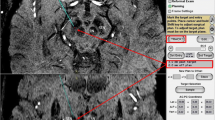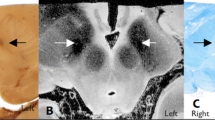Abstract
Purpose
Deep brain stimulation (DBS) relies on precise targeting of key structures such as the subthalamic nucleus (STN) for Parkinson’s disease (PD) and the ventro-intermedius nucleus of the thalamus (Vim) for essential tremor (ET). Segmentation software, such as GuideXT© and Suretune©, are commercially available for atlas-based identification of deep brain structures. However, no study has compared the concordance of the segmentation results between the two software.
Methods
We retrospectively compared the concordance of segmentation of GuideXT© and Suretune© software by comparing the position of the segmented key structures with clinically predicted targets obtained using the newly developed RebrAIn© software as a reference.
Results
We targeted the STN in 44 MRI from PD patients (88 hemispheres) and the Vim in 31 MRI from ET patients (62 hemispheres) who were elected for DBS. In 22 STN targeting (25%), the target positioning was not correlating between GuideXT© and Suretune©. Regarding the Vim, targets were located in the segmented Vim in 37%, the posterior subthalamic area (PSA) in 60%, and the STN in 3% of the cases using GuideXT©; the proportions were 34%, 60%, and 6%, respectively, using Suretune©. The mean distance from the centre of the RebrAIn© targeting to the segmented Vim by Suretune© was closer (0.64 mm) than with GuideXT© (0.96 mm; p = 0.0004).
Conclusion
While there is some level of concordance in the segmentation results of key structures for DBS treatment among software models, differences persist. Therefore, such software should still be considered as tools and should not replace clinician experience in DBS planning.


© and Suretune©) in the upper panel and the Vim (pink in GuideXT© and dark green in Suretune©) in the lower panel. B Representative images of the RebrAIn© target (white cross) considered as “inside” (left) and “outside” (right) the segmentation (STN in the upper panel and Vim in the lower panel). The white cross represents the RebrAIn© target directly marked in the MRI using OptimDBS software developed by RebrAIn©. C Representative image of the calculation of the distance “d” (yellow line) between the centre of the RebrAIn© target (white cross) and the STN in a case considered as “outside” of the segmentation
Similar content being viewed by others
Data availability
The datasets generated and analysed in this study are available from the corresponding author upon reasonable request.
Code availability
Not applicable.
References
Ashkan K, Rogers P, Bergman H, Ughratdar I (2017) Insights into the mechanisms of deep brain stimulation. Nat Rev Neurol. https://doi.org/10.1038/nrneurol.2017.105
Benabid AL, Pollak P, Hoffmann D, Gervason C, Hommel M, Perret JE, de Rougemont J, Gao DM (1991) Long-term suppression of tremor by chronic stimulation of the ventral intermediate thalamic nucleus. The Lancet. https://doi.org/10.1016/0140-6736(91)91175-T
Deuschl G, Raethjen J, Hellriegel H, Elble R (2011) Treatment of patients with essential tremor. Lancet Neurol. https://doi.org/10.1016/S1474-4422(10)70322-7
Engelhardt J, Cuny E, Guehl D et al (2021) Prediction of clinical deep brain stimulation target for essential tremor from 1.5 Tesla MRI anatomical landmarks. Front Neurol. https://doi.org/10.3389/fneur.2021.620360
Engelhardt J, Guehl D, Damon-Perrière N, Branchard O, Burbaud P, Cuny E (2019) Localization of deep brain stimulation electrode by image registration is software dependent: a comparative study between four widely used software programs. Stereotact Funct Neurosurg. https://doi.org/10.1159/000494982
Fenoy AJ, Schiess MC (2018) Comparison of tractography-assisted to atlas-based targeting for deep brain stimulation in essential tremor. Mov Disord. https://doi.org/10.1002/mds.27463
Kondapavulur S, Silva AB, Wang DD (2022) Ventral intermediate nucleus of the thalamus versus posterior subthalamic area: network meta-analysis of DBS target site efficacy for essential tremor. Stereotact Funct Neurosurg. https://doi.org/10.1159/000522573
Nowacki A, Debove I, Rossi F, Ai Schlaeppi J, Petermann K, Wiest R, Schüpbach M, Pollo C (2019) Targeting the posterior subthalamic area for essential tremor: proposal for MRI-based anatomical landmarks. J Neurosurg. https://doi.org/10.3171/2018.4.JNS18373
Papavassiliou E, Rau G, Heath S et al (2004) Thalamic deep brain stimulation for essential tremor: relation of lead location to outcome. Neurosurgery. https://doi.org/10.1227/01.NEU.0000119329.66931.9E
Sedrak M, Gorgulho A, Frew A, Behnke E, Desalles A, Pouratian N (2011) Diffusion tensor imaging and colored fractional anisotropy mapping of the ventralis intermedius nucleus of the thalamus. Neurosurgery. https://doi.org/10.1227/NEU.0b013e3182296a42
Tourdias T, Saranathan M, Levesque IR, Su J, Rutt BK (2014) Visualization of intra-thalamic nuclei with optimized white-matter-nulled MPRAGE at 7T. Neuroimage. https://doi.org/10.1016/j.neuroimage.2013.08.069
Vassal F, Coste J, Derost P, Mendes V, Gabrillargues J, Nuti C, Durif F, Lemaire JJ (2012) Direct stereotactic targeting of the ventrointermediate nucleus of the thalamus based on anatomic 1.5-T MRI mapping with a white matter attenuated inversion recovery (WAIR) sequence. Brain Stimul. https://doi.org/10.1016/j.brs.2011.10.007
Funding
This research was funded using the funds dedicated to research of the Department of Neurosurgery of Bordeaux University Hospital.
Author information
Authors and Affiliations
Contributions
Conception and design: Emmanuel Cuny.
Acquisition of samples and data: Emmanuel Cuny.
Analysis and interpretation of data: Paul Constanthin, Emmanuel Cuny, Julien Engelhardt, Nejib Zemzemi.
Statistical analysis: Paul Constanthin.
Drafting of the article: Paul Constanthin.
Critically revision of the article: all authors.
Study supervision: Emmanuel Cuny, Julien Engelhardt.
Corresponding author
Ethics declarations
Ethics approval
This research was carried out in compliance with the Declaration of Helsinki and was approved by the Institutional Review Board of the Collège de Neurochirurgie (IRB00011687 Collège de Neurochirurgie #1:2023/05). Written informed consent was obtained from participants (or their legal guardian) to participate in the study. All patients were over 18 years of age.
Consent to participate
Not applicable.
Consent for publication
Not applicable.
Conflict of interest
EC and NZ are shareholders and co-founders of the startup RebrAIn. The other authors report no conflicts of interest concerning the materials or methods used in this study or the findings presented in this paper.
Disclaimer
The funding source did not have access to the data nor did it have any influence on their analysis or the drafting of the manuscript.
Additional information
Publisher's note
Springer Nature remains neutral with regard to jurisdictional claims in published maps and institutional affiliations.
Rights and permissions
Springer Nature or its licensor (e.g. a society or other partner) holds exclusive rights to this article under a publishing agreement with the author(s) or other rightsholder(s); author self-archiving of the accepted manuscript version of this article is solely governed by the terms of such publishing agreement and applicable law.
About this article
Cite this article
Constanthin, P.E., Zemzemi, N., Cuny, E. et al. Comparison of two segmentation software tools for deep brain stimulation of the subthalamic and ventro-intermedius nuclei. Acta Neurochir 165, 3397–3402 (2023). https://doi.org/10.1007/s00701-023-05819-9
Received:
Accepted:
Published:
Issue Date:
DOI: https://doi.org/10.1007/s00701-023-05819-9




